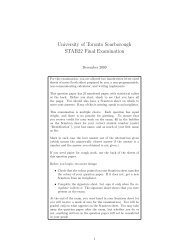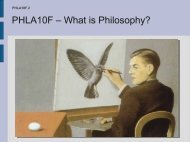Reading List - University of Toronto Scarborough
Reading List - University of Toronto Scarborough
Reading List - University of Toronto Scarborough
- No tags were found...
You also want an ePaper? Increase the reach of your titles
YUMPU automatically turns print PDFs into web optimized ePapers that Google loves.
Introduction and methodology* Cochrane, John H. (2005), “Writing Tips for Ph.D. Students”,http://faculty.chicagobooth.edu/john.cochrane/research/Papers/phd_paper_writing.pdf* Friedman, M. (1966), “The Methodology <strong>of</strong> Positive Economics”, in Essays In PositiveEconomics (Chicago: Univ. <strong>of</strong> Chicago Press), pp. 3-16, 30-43.* Krugman, P. (1997), “The Accidental Theorist”,http://web.mit.edu/krugman/www/hotdog.htmlPopper, K., “Science: Conjectures and Refutations”, in Philosophy <strong>of</strong> Science: The CentralIssues, Martin Curd and J.A. Cover, eds., W.W. Norton and Company, 1998, pp. 3-10.Samuelson, P. (1948), Economics, Chapter 1: Introduction [Search for “Economics: The Original1948 Edition” at amazon.com and click `look inside’ to read chapter 1]Individual decision-making* Kahneman, D., Knetsch, J.L. and Thaler, R.H. (1991), “Anomalies: The Endowment Effect, LossAversion, and Status Quo Bias”, The Journal <strong>of</strong> Economic Perspectives, 5(1): 193-206* Pesendorfer, W. (2006), “Behavioral Economics Comes <strong>of</strong> Age: A Review Essay on ‘Advancesin Behavioral Economics’”, Journal <strong>of</strong> Economic Literature, 44(3): 712-721* Rubinstein, A., Modeling Bounded Rationality, MIT Press, 1998, available freely athttp://arielrubinstein.tau.ac.il/br/br.pdf [Chapter 1 important; 2-5 worth looking at]DellaVigna, S. and Ulrike Malmendier (2006), “Paying Not to Go to the Gym” AmericanEconomic Review, 96(3): 694–719.Kahneman, D. and Thaler, R.H. (2006), “Anomalies: Utility Maximization and Expected Utility”,The Journal <strong>of</strong> Economic Perspectives, 20(1): 221-234Kahneman, D. and Tversky, A. (1979), “Prospect Theory: An Analysis <strong>of</strong> Decision under Risk”,Econometrica, 47(2): 263-292Laibson, D. (1997), “Golden Eggs and Hyperbolic Discounting,” Quarterly Journal <strong>of</strong> Economics,112(2): 443-478.O’Donoghue, T. and Rabin, M. (1999), “Doing It Now or Later”, American Economic Review,89(1):103-124Palacios-Huerta, I. and Serrano, R. (2006), “Rejecting small gambles under expected utility”,Economics Letters, 91(2): 250-259Rabin, M. and Thaler, R.H. (2001), “Anomalies: Risk Aversion”, The Journal <strong>of</strong> EconomicPerspectives, 15(1): 219-232.Rubinstein, A., (2001), “Comments on the Risk and Time Preferences in Economics”, Mimeo,Tel-Aviv <strong>University</strong>Rubinstein, A. (2003), “Economics and Psychology? The case <strong>of</strong> Hyperbolic Discounting,”International Economic Review, 44(4): 1207-1216Schoemaker, P.J.H. (1982), “The Expected Utility Model: Its Variants, Purposes, Evidence andLimitations”, Journal <strong>of</strong> Economic Literature, 20(2): 529-563Sen, A.K. (1977), “Rational Fools: A Critique <strong>of</strong> the Behavioral Foundations <strong>of</strong> EconomicTheory”, Philosophy and Public Affairs, 6(4): 317-344Thaler, R.H. (1988), “Anomalies: The Ultimatum Game”, The Journal <strong>of</strong> Economic Perspectives,2(4): 195-206



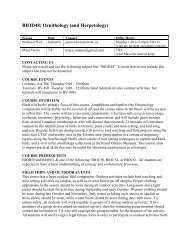
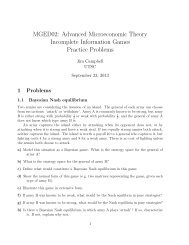


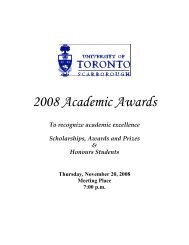
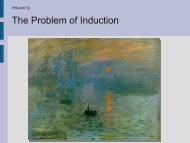
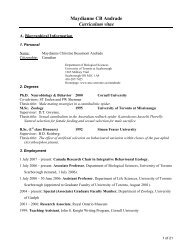
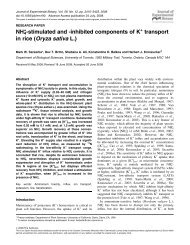
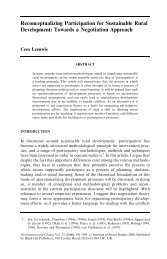
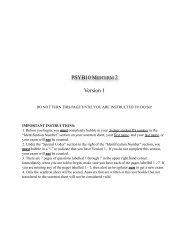
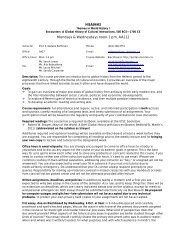
![[Enter course name - Syllabus] - University of Toronto Scarborough](https://img.yumpu.com/50068522/1/190x245/enter-course-name-syllabus-university-of-toronto-scarborough.jpg?quality=85)
